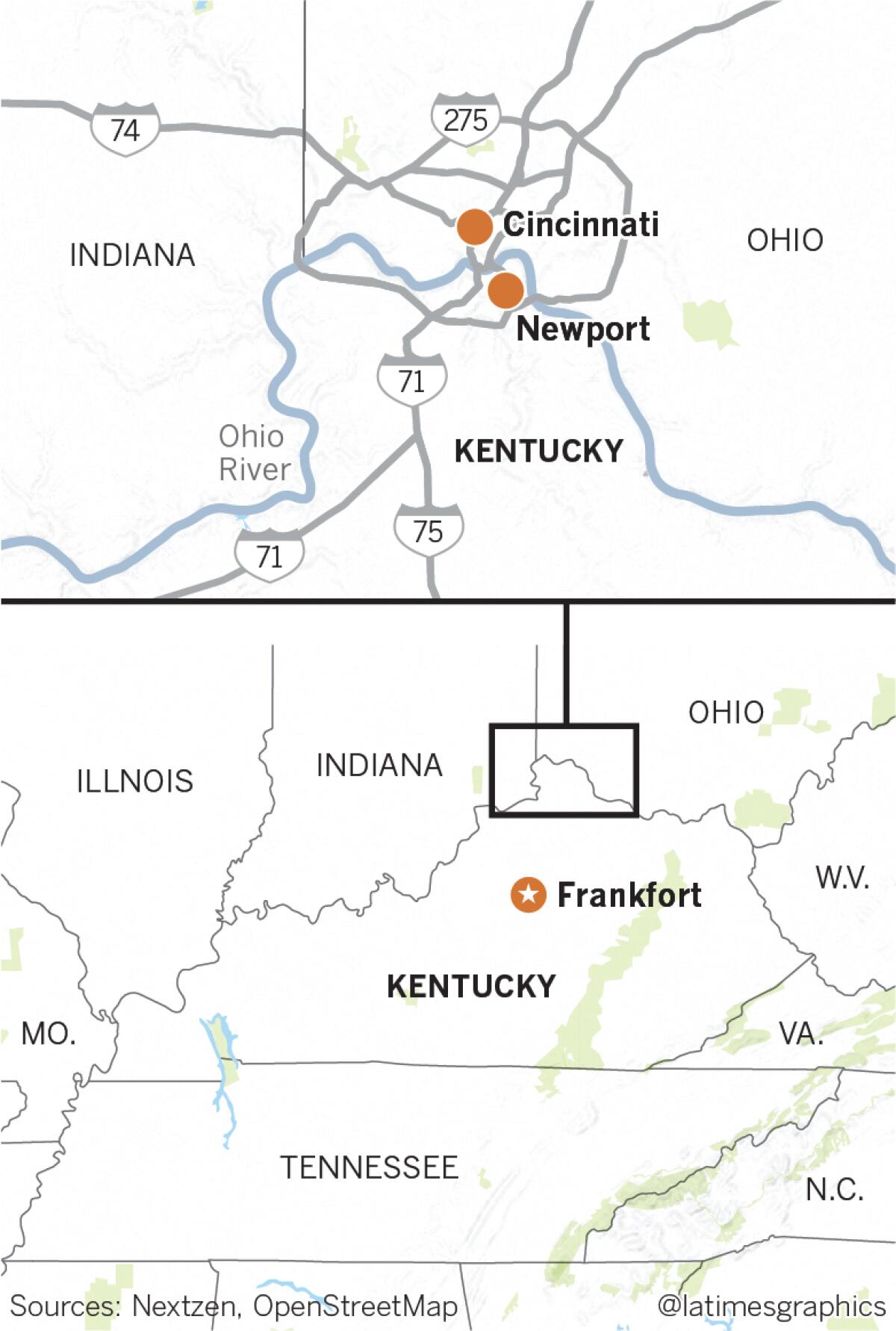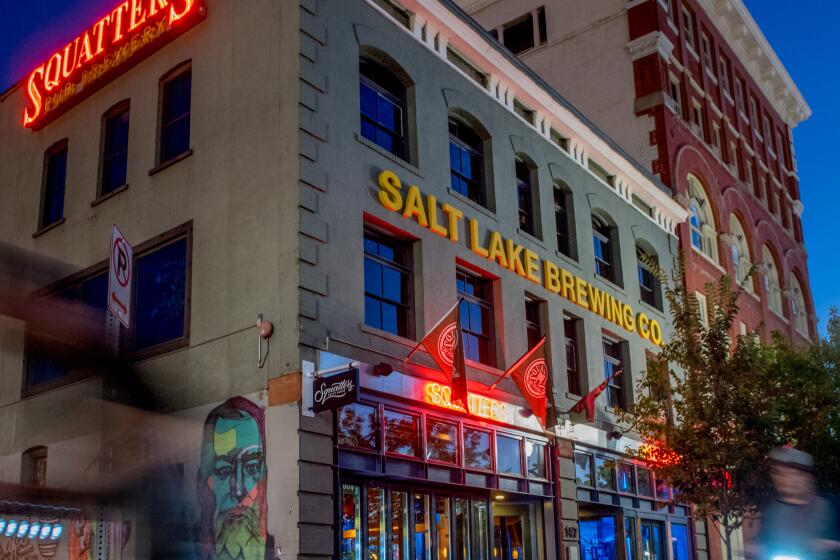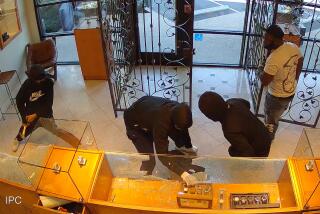How one Kentucky town almost became Vegas
- Share via
NEWPORT, Ky. — Newport’s quaint downtown has no casinos, no massive digital signs advertising Penn & Teller, Cirque du Soleil or the singing sensation du jour. There are no sprawling hotel/casino/resorts where the din is the sound of money changing hands.
Yet there was Craig Maness, a guide with American Legacy Tours, dressed in Mafia black, telling visitors how this little city across the river from Cincinnati could have been filled with those things.
Once upon a time, Newport, Maness said, was set to become what is now Las Vegas.
He spun a detailed portrait of a town on the cusp of global notoriety. Under a bright spring sky, he told that day’s crowd of travelers that mobsters from Cleveland had come to the town, which in the 1920s had declared itself an independent municipality free of state and federal controls.
George Remus, a notorious bootlegger, was first to capitalize on Newport’s independent status. Soon after casinos started to pop up. Young Frank Sinatra performed here, as did Jerry Lewis and Dean Martin, forming the nucleus of the future Rat Pack. Indeed, one of Martin’s first jobs, at age 17, was as a bartender’s assistant in Newport.

Various Vegas institutions can trace their lineage to this Kentucky town of 15,000 people. The casinos, which were tiny by modern Vegas standards, had now-familiar names, including the Flamingo, the Tropicana and the Jockey Club.
The nickname “Sin City” was first used to describe Newport. Mario Puzo, author of “The Godfather,” is said by Maness to have developed his source material from research done here.
There’s even a line in the movie “Godfather II” that pays homage to the little Kentucky town. Hyman Roth, played by Lee Strasberg, said, “Eddie Levine of Newport will bring in the Pennino Brothers, Dino and Eddie; they’ll handle actual casino operations.”
Investigative reporter Hank Messick focused his early work on Newport, which eventually prompted a few death threats. His 1995 novel “Razzle Dazzle” is named for a complicated dice game popularized here.
In an interview, lifelong resident Spiros N. Sarakatsannis, reminisced about his childhood in his parents’ popular restaurant, including playing hide and seek among the slot machines.
“The restaurant was open 24 hours a day, and we had people here 24 hours a day,” he said. “A lot of them would come over from the Beverly Hills Night Club after it closed at 2:30 [a.m.]” Sarakatsannis recounted repeated visits by Jack Benny and the Marx Brothers and notes that a young Bob Hope was so broke that he could afford only two chili-covered hot dogs and water.
We may think we know our country, but its treasures can still surprise us.
By 1950 the town’s population had grown to more than 30,000 people. By 1960 the Saturday Evening Post ran an eight-page exposé of Newport called “Kentucky’s Open City.” The subhead noted that the city “flourishes as one of the nation’s biggest illegal gambling centers.”
Newport Mayor Jerry R. Peluso, the son of Italian immigrants who ran the town’s only Italian market, recalled that as a boy, he made deliveries to the casinos (and received big tips from the purveyors). At age 12, he saw a man shot to death as he left a barber shop.
Johnny Peluso, Jerry’s uncle, served for 18 years as an elected official in Newport and could be found at a craps table with Sammy Davis Jr. and Dean Martin. Marilyn Monroe was singing at venues on Monmouth Street. Newport’s star was rising fast.
But it all changed in 1961 when the mob went too far.
On May 9 at 2:40 a.m., three Newport city detectives burst into Room 314 of the Glenn Hotel. They arrested a man clad only in shirt and socks and a woman wearing nothing but a negligee. He was George Ratterman, formerly a Notre Dame and Cleveland Browns football star and a reform candidate for sheriff. She was a stripper named Juanita Hodges (a.k.a. April Flowers).
In a highly publicized trial, the case against Ratterman quickly unraveled once a doctor proved that he had been knocked out by a dose of choral hydrate. The mob had tried to frame him. Ratterman went on to win the election, and the Mafia’s brazen actions convinced state and local officials that it was time to act.
Best bars in Salt Lake City
The governor declared a state of emergency in the county and raided the casinos for possible liquor and fire code violations. The federal government got involved when then-U.S. Atty. Gen. Robert F. Kennedy, who admired Ratterman from his football-playing days, asked Congress to pass legislation that would enable the Justice Department to target mobsters, specifically those in Newport, operating across state lines.
Kennedy’s feds had spotted a number of telephone lines coming from the Yorkshire Club (the lines were used to get the results of horse races and sports events around the country) and realized that they crossed state lines. The feds shut the Yorkshire, which was bringing in as much as $1 million a month.
The mob realized it was time to go as county, state and federal governments tightened their grip on the casinos, especially because they were more opportunities in Nevada. As the casinos packed up, so did about half of Newport’s population.
“Gambling was all these casino employees knew,” Jerry Peluso said. “That’s all they did. So when the casinos left, they went to Vegas to keep their jobs.”
Since this brush with infamy, Newport’s population is now about what it was in 1870 and the population continues to decline slowly. Rather than gambling and entertainment, the city’s primary industries are manufacturing, retail and food service.
But there is growth and development, especially around tourism. Newport on the Levee is an entertainment complex filled with higher-end chain restaurants, an aquarium, IMAX theater and retail.
The sprawling Hofbrauhaus restaurant, which pays homage to the region’s German history, is busy. The 5-year-old New Riff Distilling is winning national awards for craft bourbon, rye and gin and is a highlight of the B-Line, an assemblage of distilleries and bourbon-centric bars in Newport and neighboring communities.
Although Peluso had asked the founders of American Legacy Tours to not publicize the city’s gangster past, he realized the opportunity once he saw the turnout. The company, now endorsed by the mayor, has expanded to offer more than a dozen tours around the region and expects to handle more than 30,000 tourgoers this summer. Those aren’t exactly Vegas numbers, but Peluso and this tight-knit little community will take it.
More to Read
Sign up for The Wild
We’ll help you find the best places to hike, bike and run, as well as the perfect silent spots for meditation and yoga.
You may occasionally receive promotional content from the Los Angeles Times.







